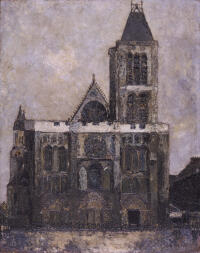Vincent van Gogh
03.07.1924 – 10.08.1924
Location Kunsthaus.
Location Kunsthaus.
“Passion streams towards us like hot breath”
Hardly any artist’s life has been narrated as often as that of Vincent van Gogh (b. 1853 Groot-Zundert, d. 1890 in Auvers-sur-Oise). In more than 600 letters between the artist and his brother Theo all stations of his short and unhappy life are recorded, so that it is not surprising that the interest of posterity in the genius who enjoyed no recognition in his lifetime, has always been great. But Kunsthaus Director Wilhelm Wartmann was concerned less with the widespread knowledge of his biography than with van Gogh’s art: “The work as a whole is of unswerving consistency even with its changing surface aspect and […] external development.”
With the exhibition in the Kunsthaus Wartmann wanted to show the “authentic beauty” of van Gogh’s work. The 75 displayed works, including paintings and sketches, were from the earliest years, but also from the time in Paris and southern France, such as the striking Night Café (1888) and Garden of the Asylum in Saint-Rémy (1889). Also, his final station in Auvers-sur-Oise, where van Gogh lived from May to July 1890, was documented with Mairie d’Auvers-sur-Oise (1890). In this small town, north-west from Paris, van Gugh shot himself in the chest on July 27, 1890, and died two days later.
The show was a great success with the public so that it was extended by a week. And hardly any other exhibition was received so broadly and in such detail as that of van Gogh – in some cases over several pages or as a series in several parts. In the Gazette de Lausanne pleasure was taken in the richness of the works and it was prophesied that the artist’s fame could only increase. In the Tages-Anzeiger thee artist was honored, even with a certain reserve, as follows: “Out of every painting speaks artistic seriousness, a powerful, engrossing, even harrowing world of feeling, the artist’s need to communicate himself and his feelings to the viewer.” In the NZZ the review of the exhibition was even panegyric, and the artist – without much distance and passing over the artist’s sufferings – was celebrated as an exceptional phenomenon: “The powerful, deep, and stormy artist personality shines down to us from the walls in its rapturous uniqueness.”
The exhibition was accompanied by a catalog with an introductory text by Wilhelm Wartmann and a list of works.
[Peter Stohler]
Further information
In the Tages-Anzeiger thee artist was honored, even with a certain reserve, as follows: “Out of every painting speaks artistic seriousness, a powerful, engrossing, even harrowing world of feeling, the artist’s need to communicate himself and his feelings to the viewer.”

exhibition catalog
